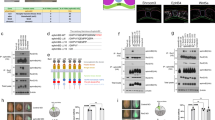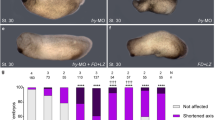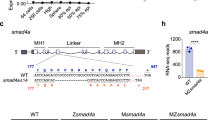Abstract
Early spherical Xenopus laevis embryos are transformed into a streamlined shape through convergent extension movements. Here we report that a p75NTR-related transmembrane protein, NRH1, has an essential function in the regulation of these movements. NRH1 was expressed in marginal zone tissues of the gastrula and in the posterior ectoderm of the neurula. Attenuation of the NRH1 function inhibited convergent extension movements in the embryo and in activin-treated animal caps. NRH1 activated downstream effectors of the Wnt/planar cell polarity pathway: small GTPases and the cascade of MKK7–JNK. Furthermore, gain- and loss-of-function phenotypes of NRH1 were rescued by co-injection of dominant-negative and constitutively active forms of these downstream effectors, respectively, suggesting that NRH1 functions as a positive modulator of planar cell polarity signalling. Interestingly, NRH1 does not require Dishevelled (Xdsh) for the activation of these downstream effectors or translocation of Xdsh to the membrane, suggesting that NRH1 signalling interacts with planar cell polarity signalling downstream of Xdsh. This demonstrates an essential role for p75NTR-related signalling in early embryonic morphogenesis.
This is a preview of subscription content, access via your institution
Access options
Subscribe to this journal
Receive 12 print issues and online access
$209.00 per year
only $17.42 per issue
Buy this article
- Purchase on Springer Link
- Instant access to full article PDF
Prices may be subject to local taxes which are calculated during checkout





Similar content being viewed by others
References
Sasai, N., Mizuseki, K. & Sasai, Y. Requirement of FoxD3-class signaling for neural crest determination in Xenopus. Development 128, 2525–2536 (2001).
Huston, L.D. & Bothwell, M. Expression and function of Xenopus laevis p75NTR suggest evolution of developmental regulatory mechanisms. J. Neurobiol. 49, 79–98 (2001).
Roux, R.P. & Barker, P.A. Neurotrophin signaling through the p75 neurotrophin receptor. Prog. Neurobiol. 67, 203–233 (2002).
Djiane, A., Riou, J., Umbhauer, M., Boucaut, J. & Shi, D. Role of frizzled7 in the regulation of convergent extension movements during gastrulation in Xenopus laevis. Development 127, 3091–3100 (2000).
Moon, R.T. et al. Xwnt-5A: a maternal Wnt that affects morphogenetic movements after overexpression in embryos of Xenopus laevis. Development 119, 97–111 (1993).
Veeman, M.T., Axelrod, J.D. & Moon, R.T. A second canon: functions and mechanisms of β-catenin-independent Wnt signaling. Dev. Cell 5, 367–377 (2003).
Winklbauer, R., Medina, A., Swain, R.K. & Steinbeisser, H. Frizzled-7 signaling controls tissue separation during Xenopus gastrulation. Nature 413, 856–860 (2001).
Wallingford, J.B., Fraser, S.E. & Harland, R.M. Convergent extension: the molecular control of polarized cell movement during embryonic development. Dev. Cell 2, 695–706 (2002).
Tada, M. & Smith, J.C. Xwnt11 is a target of Xenopus Brachyury: regulation of gastrulation movements via Dishevelled, but not through the canonical Wnt pathway. Development 127, 2227–2238 (2000).
Choi, S. & Han, J. Xenopus Cdc42 regulates convergent extension movements during gastrulation through Wnt/Ca2+ signaling pathway. Dev. Biol. 244, 342–357 (2002).
Habas, R., Kato, Y. & He, X. Wnt/Frizzled activation of Rho regulates vertebrate gastrulation and requires a novel Formin homology protein Daam1. Cell 107, 843–854 (2001).
Habas, R., Dawid, I. & He, X. Coactivation of Rac and Rho by Wnt/ Frizzled signaling is required for vertebrate gastrulation. Genes Dev. 17, 295–307 (2003).
Penzo-Mendèz, A., Umbhauer, M., Djiane, A., Boucaut, J.-C. & Riou, J.-F. Activation of Gβγ signaling downstream of Wnt-11/Xfz7 regulates Cdc42 activity during Xenopus gastrulation. Dev. Biol. 257, 302–314 (2003).
Strutt, D.I., Weber, U. & Mlodzik, M. The role of RhoA in tissue polarity and Frizzled signalling. Nature 387, 292–295 (1997).
Medina, A. & Steinbeisser, H. Interaction of Frizzled 7 and Dishevelled in Xenopus. Dev. Dyn. 218, 671–680 (2000).
Sumanas, S., Strege, P., Heasman, J. & Ekker, S.C. The putative Wnt receptor Xenopus frizzled-7 functions upstream of β-catenin in vertebrate dorsoventral mesodermal patterning. Development 127, 1981–1990 (2000).
Deardorff, M.A., Tan, C., Conrad, L.J. & Klein, P.S. Frizzled-8 is expressed in the Spemann organizer and plays a role in early morphogenesis. Development 125, 2687–2700 (1998).
Wallingford, J.B. et al. Dishevelled controls cell polarity during Xenopus gastrulation. Nature 405, 81–85 (2000).
Kinoshita, N., Iioka, H., Miyakoshi, A. & Ueno, N. PKCδ is essential for Dishevelled function in a noncanonical Wnt pathway that regulates Xenopus convergent extension movements. Genes Dev. 17, 1663–1676 (2002).
Yamanaka, H. et al. JNK functions in the non-canonical Wnt pathway to regulate convergent extension movements in vertebrates. EMBO Rep. 3, 69–75 (2002).
Sheldahl, L.C. et al. Dishevelled activates Ca2+ flux, PKC, and CamKII in vertebrate embryos. J. Cell Biol. 161, 769–777 (2003).
Rothbächer, U. et al. Dishevelled phosphorylation, subcellular localization and multimerization regulate its role in early embryogenesis. EMBO J. 19, 1010–1022 (2000).
Yamashita, S. et al. Stat3 controls cell movements during zebrafish gastrulation. Dev. Cell 2, 363–375 (2002).
Yamashita, T., Tucker, K.L. & Barde, Y.-A. Neurotrophin binding to the p75 receptor modulates Rho activity and axonal outgrowth. Neuron 24, 585–593 (1999).
Yamashita, T. & Tohyama, M. The p75 receptor acts as a displacement factor that releases Rho from Rho-GDI. Nature Neurosci. 6, 461–467 (2003).
Saneyoshi, T., Kume, S., Amasaki, Y. & Mikoshiba, K. The Wnt/calcium pathway activates NF-AT and promotes ventral cell fate in Xenopus embryos. Nature 417, 295–299 (2002).
Numakawa, T. et al. Nerve growth factor-induced glutamate release is via p75 receptor, ceramide, and Ca from ryanodine receptor in developing cerebellar neurons. J. Biol. Chem. 42, 41259–41269 (2003).
Wang, K.C., Kim, J.A., Sivasankaran, R., Segal, R. & He, Z. p75 interacts with the Nogo receptor as a co-receptor for Nogo, MAG and OMgp. Nature 420, 74–78 (2002).
Nishinakamura, R. et al. Activation of Stat3 by cytokine receptor gp130 ventralizes Xenopus embryos independent of BMP-4. Dev. Biol. 216, 481–490 (1999).
Acknowledgements
We are grateful to T. Hirano, T. Yokota and R. Nishinakamura for plasmids; H. Steinbeisser, M. Tada, T. Yamashita, M. Hibi, H. Enomoto and R. Ladher for their advice and comments on this work; H. Inomata for discussion and M. Matsumura for technical assistance. This work was supported by grants to Y.S. from MEXT, the Kobe Cluster Project and the Leading Project.
Author information
Authors and Affiliations
Corresponding author
Ethics declarations
Competing interests
The authors declare no competing financial interests.
Supplementary information
Rights and permissions
About this article
Cite this article
Sasai, N., Nakazawa, Y., Haraguchi, T. et al. The neurotrophin-receptor-related protein NRH1 is essential for convergent extension movements. Nat Cell Biol 6, 741–748 (2004). https://doi.org/10.1038/ncb1158
Received:
Accepted:
Published:
Issue Date:
DOI: https://doi.org/10.1038/ncb1158
This article is cited by
-
Comprehending the crosstalk between Notch, Wnt and Hedgehog signaling pathways in oral squamous cell carcinoma - clinical implications
Cellular Oncology (2021)
-
Comprehensive Analysis of the Canonical and Non-canonical Wnt Signaling Pathways in Gastric Cancer
Digestive Diseases and Sciences (2019)
-
Modulation of Wnt signaling pathway by hepatitis B virus
Archives of Virology (2017)
-
Molecular basis of morphogenesis during vertebrate gastrulation
Cellular and Molecular Life Sciences (2009)
-
RhoA and microtubule dynamics control cell–basement membrane interaction in EMT during gastrulation
Nature Cell Biology (2008)



